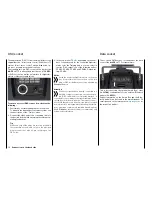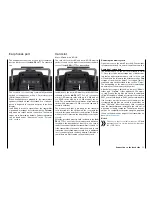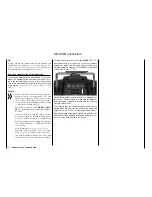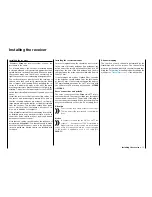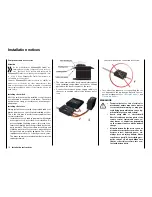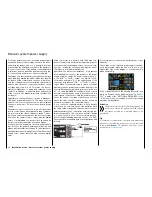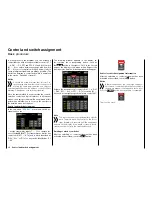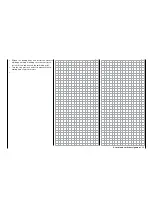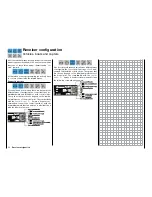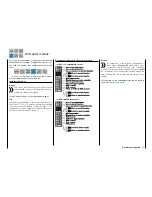
Definition of terms
Control function, control, function input, control channel, mixer, switch, control and logical switch
To make it easier to use the Part 2 of the manual, we
offer a few definitions of terms that appear repeatedly
in the manual.
Control function
A control function is understood as the signal for a
specific control function independent of the signal
within the transmitter. In fixed-wing models set e.g.
the control signals would be throttle, rudder or aileron;
in helicopter models, these would be e.g. pitch, roll
or nick.
The signal of a control function can be transmitted
directly into one control channel or through a mixer
to several control channels. A typical example of the
latter are separate aileron servos, or the use of two roll
or elevation servos in helicopters. The control function
includes the influence of the mechanical control path
on the corresponding servo. This can be spread or
concentrated and modified from linear to highly ex-
ponential.
Controls
Controls are the control elements on the transmitter
that are activated directly by the pilot that control the
connected servos, speed controllers, etc. on the re-
ceiver. These include:
• The two control sticks for control functions 1 to
4, including the related trims. These four functions
in all the six model types (vehicle, boat, copter,
helicopter, motor airplane and glider) can be ex-
changed using the mode setting in the software,
such as throttle left or right. Throttle/brake or throt-
tle/pitch left or right. The control stick function for
Throttle/brake flap control for fixed-wing models
or throttle/pitch control in helicopters is frequently
identified as the THR control (channel 1).
• the four proportional dials (DV1 … DV4)
• The two side proportional rotary controls SL1 and
SL2 mounted on the bottom.
• Switches S1 … S8
• the INC/DEC buttons DT1 and DT2
With the type DV and SL proportional controls as well
as the INC/DEC buttons, the servos directly follow the
control position, whereas only a two or three-stage
adjustment is possible with a switch.
The assignment of the controls and switches to the
servos 5 …12 is freely programmable.
Function input
This is an imaginary point in the signal flow and should
not be confused with the control connection on the
printed circuit board. The selected control mode and
the settings "TX OUT SET" line of the "
"CTL Set"
"
sub-menu (transmitter setting) of the base menu influ-
ence the sequence beyond the physical connecting
points and this can generate differences between the
number of function inputs and the number of subse-
quent control channels.
Control channel
From the point at which a signal contains all control
information necessary for a particular servo, whether
directly from the control or indirectly via a mixer, the
term control channel is used.
For example, the "aileron" control function of a fixed-
wing model for the model type "2AILE" is divided into
control channels for the left and right aileron. Analo-
gously, the "Roll" control function for the helicopter
model "3Sv(2Roll)" governs the control channels for
both the left and right roll servo.
This signal is only influenced by the settings made in
the sub-menus "
E.P.A
" (servo path/servo limit), "
REV/
SUB
" (servo direction reverse/delay) and "Sub-Trim"
(servo middle and neutral position) to adjust the ser-
vo, and possibly the settings in the sub-menu "
Out.
Swap
" (transmitter output) and is then transmitted by
the transmitter through the RF module. Once it arrives
in the receiver, this signal may be modified by settings
saved in the "
Telemetry
" menu, after which it controls
the associated servo.
Mixer
The transmitter program contains a variety of mixing
functions. These allow a control function to influence
several control channels and as final result several
servos or even many control functions to influence the
same one servo.
In this context, you can refer to the numerous mixing
functions.
Switch
The series of toggle switches S1 … S8 can also be in-
cluded in the control programming. The switches are
however generally also intended to switch program
options such as to start and stop the timers, turn mix-
ers on and off, as trainer switches etc. Each of the
switches can be assigned any number of functions.
Related examples are listed in the manual.
Control switch
Since it is occasionally practical to automatically
switch a timer or a function on or off when a control
is in a specific position (a stopwatch turns on/off to
measure engine operating times), the program for the
mz-24
HoTT Pro transmitter also allows you to pro-
gram control switches.
24
Definition of terms
Summary of Contents for mz-24 PRO
Page 13: ...13 Personal notes...
Page 19: ...19 Personal notes...
Page 37: ...37 Personal notes...
Page 59: ...Touch 59 Base menu Model selection...
Page 79: ...79 Personal notes...
Page 89: ...89 Personal notes...
Page 115: ...115 Personal notes...
Page 153: ...Helicopter model function menus Common function menus 153 Personal notes...
Page 169: ...169 Personal notes...
Page 187: ...187 Personal notes...
Page 199: ...199 Personal notes...
Page 207: ...Fixed wing model function menus System menus 207 Personal notes...
Page 211: ...211 Personal notes...
Page 219: ...219 Personal notes...
Page 237: ...237 Personal notes...
Page 238: ...238 Personal notes...
Page 239: ...239 Personal notes...

